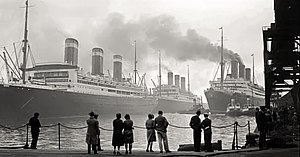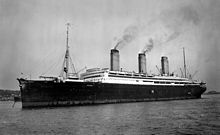This article needs additional citations for verification. (May 2022) |
 Photograph of the three former Imperator-class liners from left to right: SS Leviathan (former SS Vaterland), RMS Majestic (former SS Bismarck), and RMS Berengaria (former SS Imperator), photographed side by side in Southampton, England
| |
| Class overview | |
|---|---|
| Builders | Imperator: AG Vulcan Stettin, Germany Vaterland/Majestic: Blohm+Voss, Hamburg, Germany |
| Built | 1912–1914 |
| In service | 1913–1946 |
| Planned | 3 |
| Completed | 3 |
| Lost | 1 |
| Retired | 2 |
| General characteristics | |
| Type | Ocean liner |
| Tonnage | 52,117 - 56,551 GRT |
| Length | 906–956 ft (276–291 m) |
| Beam | 98 ft 3 in (29.9 m) to 100 ft 1 in (30.5 m) |
| Draught | 35 ft 2 in (10.7 m) to 37 ft 9 in (11.5 m) |
| Decks | 11 |

The Imperator-class was a series of three large ocean liners designed and built for the Hamburg America Line (HAPAG). Envisaged by HAPAG chairman, Albert Ballin, the three ships - Imperator, launched in 1912; Vaterland, launched in 1913; and Bismarck, launched in 1914 - each displaced over 50,000 tons, with each successively holding the title of the world's largest passenger ship. All three were interred by the United States during the First World War, and were turned over to the Allies as reparations following the war's end.